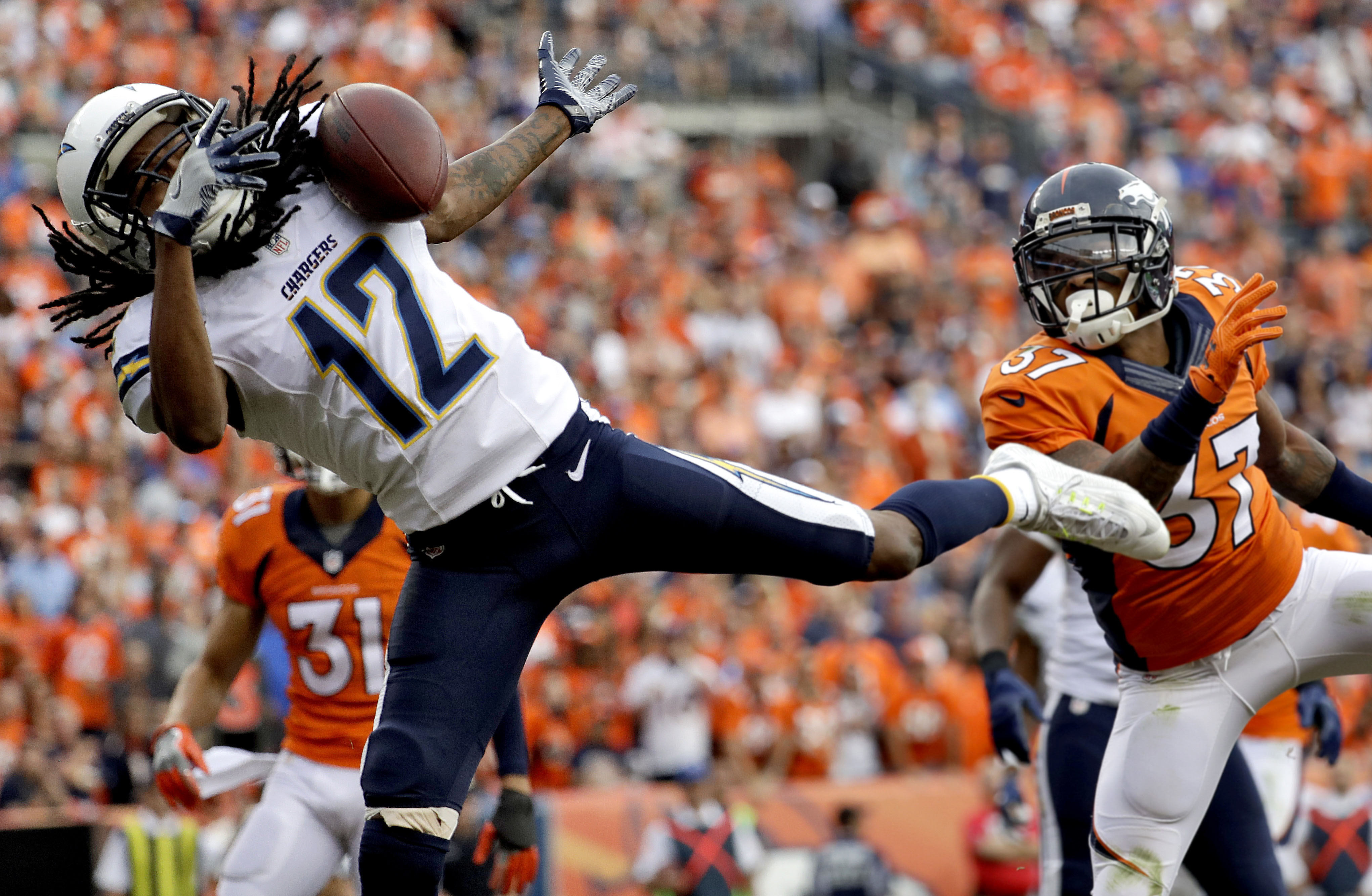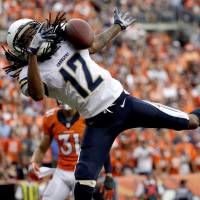San Diego may lose its NFL Chargers. And because MAS considers himself an honorary San Diegan, he is despondent over that possibility. Why? Well, it's a long but — MAS hopes — interesting story. So, here goes.
Just one look, that's all it took.
Anyone who has ever been to San Diego, California, can understand how MAS instantly fell head-over-heels in love with the place. It happened one mid-1970s summer when he motored there cross-country from Philadelphia in his VW Bug to visit his cutie-pie daughter Kimmy, aka "Li'l Dumplin' " (for an inscription on an adorable jumpsuit she wore as a baby).
Back then San Diego was more of a quaint town than a big city. Everyone, it seemed, lived in a Spanish hacienda-style bungalow on a palm tree-lined street — think Kelly McGillis' residence in "Top Gun."
And many of those arched-entrance dwellings had some form of citrus plant in the backyard. For a then-little-traveled guy from Philly, seeing orange trees and swaying palms in real life for the first time was a downright awesome experience.
And there was so much to take in while enjoying the always balmy weather: Pacific and Ocean Beaches, humongously lovely Balboa Park, the world-famous San Diego Zoo, myriad water activities on Mission Bay, hotsy-totsy LaJolla and Coronado and on and on.
(And, yes, there was even the occasional Tijuana sojourn for the, um, nightlife and bullfights.)
But to a sports nut like MAS, most importantly, San Diego also had its Chargers and Padres.
While he was there, the latter sported their unforgettable French's mustard yellow and friar's cloak brown unis.
Ever since that trip, MAS has had a strong yearning to move full time to this delightful place. But other opportunities and certain situations have somehow always prevented him from doing so.
When MAS hit town, the Chargers had predated the Pads, who were a newly minted expansion franchise, struggling both on the field and at the gate.
Conversely, the Bolts (as the Chargers were called locally) were well established. They had been an American Football League power in the early 1960s before being absorbed into the NFL later that decade.
In those earlier AFL halcyon days, the Chargers featured the aerial artistry of quarterback John Hadl, the pass-snagging of nimble Lance "Bambi" Alworth, and versatile and handsome halfback Keith Lincoln, the AFL's answer to resident NFL glamour-puss Frank Gifford of the New York Giants.
The pre-MAS-visit Bolts were charismatic and played an exciting, wide-open style of ball. As a kid watching them on TV from chilly Philly, MAS always thought the Chargers were the epitome of cool, with their distinctive powder-blue jerseys with lightning bolts on their UCLA-style shoulder stripes. Powder blue! Who dared wear pastels back then?
For home games, the Chargers' always-packed cozy (capacity: 34,000), sun-splashed Balboa Stadium, a horseshoe-shaped edifice that featured magnificent Corinthian-style columns in its open end. Back then, cities named their playing sites after explorers and other great people, not corporations.
The AFL may have had trouble drawing fans in other places, but not San Diego. The Chargers were its pride and joy. Until a population boom took place years later, the Padres could not make the same claim.
That San Diego summer, MAS, then a high school football coach and teacher, could easily grab reasonably priced, front-row Pads seats behind the dugout at newly built Jack Murphy Stadium. Crowds of just 2,000 were not uncommon.
MAS will never forget being close enough to hear Willie Mays, then winding down his playing career with the New York Mets, spurn an elderly lady's pre-game request for an autograph, semi-politely saying: "I can't now, ma'am; I have to go to work."
Cold from the supposed "Say Hey Kid"? Perhaps. But, then again, the guy did have a job to do.
Eventually, though, the Pads caught on in San Diego. But probably never to the extent the Chargers had. It's an edge in popularity the Bolts still enjoy.
By the time of that first MAS visit, "The Murph" had also replaced gracefully aging Balboa as the Chargers' home. The Bolts filled it weekly, too. Later renamed Qualcomm Stadium, it is one of only two 1960s-70s cookie cutter, multisport stadiums still in use.
And as such, of late it has become an albatross around the team's neck that threatens their very existence as the San Diego Chargers.
Here's the lowdown on that. For most of the team's history, the Spanos family has owned and run the Chargers. First owner Alex Spanos called all the shots. Now his son Dean serves as team prez.
The Spanoses must love San Diego as much as MAS. But not quite enough people there have loved them back lately, or so it seems.
How else to explain that, on numerous occasions in recent years, San Diegans have voted down proposals for a new public-funded football-only stadium. Some NFL cities — right or wrong — have had two new grid stadiums built since Qualcomm opened in 1967.
(The less-popular Padres, meanwhile, were somehow gifted with their posh Petco Park digs near the Gaslight District downtown. Go figure!)
Chargers fans are indeed fortunate that, over the years, the Spanos family has persisted in their attempts to get a new stadium built when other NFL owners would have long ago used vote-approval failures as an excuse to get the hell out of Dodge.
But even the Spanoses can only take so much rejection. Last winter, Alex Spanos, too, had had enough and reluctantly — some say with a broken heart — attempted to move his team to Los Angeles.
However, he lost an NFL owners relocation vote to deeper-pocketed St. Louis Rams owner Stan Kroenke, who got to take his team to La La Land instead.
Had the Spanoses won, the current Tinseltown gridiron hoopla would have surrounded the L.A. Chargers, and not the return of the city's long-lost Rams.
So, San Diego remains the Chargers' home — but maybe for this season only. The team has a year to accept a standing offer to move to L.A. and become tenants in the Rams' soon-to-be-built super-duper stadium.
But before the Spanoses would ink such a deal, enough ticks remain on the clock for San Diegans to complete a "Hail Mary" pass.
Y'see, yet another stadium vote will take place next week. On Nov. 8, residents will decide on a proposed hotel tax that would produce funds for a new stadium. A two-thirds majority is needed for the measure to pass.
Should it too fail, the Chargers will almost surely be gone. Hard to believe. After some 60 years.
By now, MAS is totally befuddled by the frequent vote-downs. Maybe San Diegans feel they have enough on their Sunday activity plate. Perhaps they consider it to be the fiscally prudent thing to do.
But however the folks there vote this final time, he will respect their decision.
MAS has been back to San Diego on numerous occasions since that memorable first visit, including the time he proudly attended the San Diego State graduation of his by-then-grown up and beautiful LD (what MAS still calls his Li'l Dumplin' for short).
In truth, San Diego is not quite as charming these days. Urban development has taken its toll. It may not be a quaint "town" anymore but the city it has morphed into is still a fabulous one.
Thus, MAS has not stopped his San Diego dreamin'. He retains hope that, one day, the situation will be right for him to return there permanently.
If he does, MAS sure hopes the Chargers will be waiting for him.
Contact MAS at [email protected]



















With your current subscription plan you can comment on stories. However, before writing your first comment, please create a display name in the Profile section of your subscriber account page.